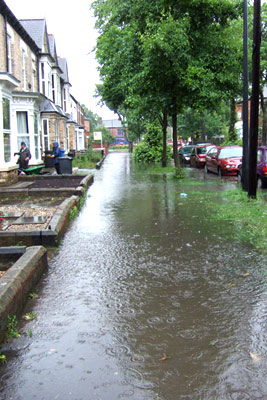
Marlborough Avenue, Hull, on Monday 25 June 2007, at 4.10 pm
Approximate calculations
In order to see whether the scheme proposed actually works out, precise data is required. However, using approximate figures one can get an impression of whether it worth doing more accurate calculations.
If each household holds back 1 cu.m. of water and the share of the total area of the neighbourhood attributable to one household is 200 sq.m. then the difference to the water level if evenly spread will be only ½ cm. which of course is hardly significant. However, what actually happens is that water not held back or drained away flows to areas slightly lower and accumulates in those areas. This flow occurs either across the surface or via the drains, going down the drain in one place and coming up in another.
If the ratio of low areas, now covered in water, to higher areas not affected at the peak of unrestrained flooding is 1:10 then the difference that holding back 1 cu.m. for every 200 sq.m. becomes 5 cm. rather than 1/2 cm. This is still only a small amount but many homes, perhaps thousands, were within that amount of being flooded up to what we might call ‘carpet level’.
At first these ‘pooled’ areas will be small but as the amount of water increases gradually the whole are will be affected. What occurred in June 2007 was that a relatively small fraction of the whole area of Hull was affected seriously with hundreds of people having to move out of their houses while repairs and replacements were carried out, often taking months. (The exact number of properties affected is a matter of definition but it seems to have been roughly in the low thousands.)
What this scheme is intended to alleviate is this intermediate level of flooding where a small volume held back can make a significant difference to the seriousness of the flooding for the small fraction of residents who live in slightly (say less than 1m) lower areas. The cost of a modest version of the scheme could be very low if for instance it consists of simply recommending people to install water butts to gather roof water and to empty them when very heavy rain is expected.
This rough proposal is not intended to be definitive and conclusive. Better data and careful calculations are required. It does seem to have basic merit and therefore be worth pursuing. At least its public discussion will raise awareness of this significant economic issue and perhaps lead to a properly worked out practical scheme.
Flood and Water management Bill
From the DEFRA website: "The draft bill will create a simpler and effective means of managing the risk of flood and coastal erosion. It will also help improve the sustainability of our water resources and protect against potential droughts." Details at: www.defra.gov.uk/environment/water/flooding/flow/